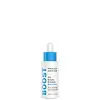Prequel Reactive Skin Solutions 5% Ectoin Cream Versus Paula's Choice Ectoin + Hyaluronic Acid Milky Hydrating Serum
What's inside
What's inside
 Key Ingredients
Key Ingredients

 Benefits
Benefits

 Concerns
Concerns

 Ingredients Side-by-side
Ingredients Side-by-side

Water
Skin ConditioningCetearyl Alcohol
EmollientEctoin
Skin ConditioningUrea
BufferingCetearyl Isononanoate
EmollientGlycerin
HumectantSimmondsia Chinensis Seed Oil
EmollientPentylene Glycol
Skin ConditioningHydrogenated Polydecene
EmollientHydroxyethyl Urea
HumectantTriacetin
AntimicrobialPanthenol
Skin ConditioningLecithin
EmollientAllantoin
Skin ConditioningSodium Cetearyl Sulfate
CleansingXanthan Gum
EmulsifyingCetearyl Glucoside
EmulsifyingSodium Lactate
BufferingEthylhexylglycerin
Skin ConditioningWater, Cetearyl Alcohol, Ectoin, Urea, Cetearyl Isononanoate, Glycerin, Simmondsia Chinensis Seed Oil, Pentylene Glycol, Hydrogenated Polydecene, Hydroxyethyl Urea, Triacetin, Panthenol, Lecithin, Allantoin, Sodium Cetearyl Sulfate, Xanthan Gum, Cetearyl Glucoside, Sodium Lactate, Ethylhexylglycerin
Water
Skin ConditioningEctoin
Skin ConditioningIsopentyldiol
HumectantTriethylhexanoin
MaskingDiisopropyl Adipate
EmollientIsoamyl Laurate
EmollientDicaprylyl Carbonate
EmollientUndecane
EmollientPolyglyceryl-4 Oleate
EmulsifyingSqualane
EmollientTridecane
PerfumingPolyglyceryl-6 Oleate
EmulsifyingPolyhydroxystearic Acid
Emulsifying1,2-Hexanediol
Skin ConditioningSimmondsia Chinensis Seed Oil
EmollientSodium Hyaluronate
HumectantCaprylic/Capric Triglyceride
MaskingTocopherol
AntioxidantHydroxyacetophenone
AntioxidantGlycogen
HumectantCoco-Caprylate/Caprate
EmollientHydrogenated Olive Oil Unsaponifiables
EmollientSodium Phytate
Citric Acid
BufferingStearalkonium Hectorite
Gel FormingPolyglyceryl-3 Diisostearate
EmulsifyingPolyglyceryl-3 Polyricinoleate
EmulsifyingWater, Ectoin, Isopentyldiol, Triethylhexanoin, Diisopropyl Adipate, Isoamyl Laurate, Dicaprylyl Carbonate, Undecane, Polyglyceryl-4 Oleate, Squalane, Tridecane, Polyglyceryl-6 Oleate, Polyhydroxystearic Acid, 1,2-Hexanediol, Simmondsia Chinensis Seed Oil, Sodium Hyaluronate, Caprylic/Capric Triglyceride, Tocopherol, Hydroxyacetophenone, Glycogen, Coco-Caprylate/Caprate, Hydrogenated Olive Oil Unsaponifiables, Sodium Phytate, Citric Acid, Stearalkonium Hectorite, Polyglyceryl-3 Diisostearate, Polyglyceryl-3 Polyricinoleate
Ingredients Explained
These ingredients are found in both products.
Ingredients higher up in an ingredient list are typically present in a larger amount.
Ectoin is a compound found naturally in some species of bacteria. It can be synthetically created for skincare use.
This ingredient is an osmolyte; Osmolytes help organisms survive osmotic shock (it protects them from extreme conditions). It does this by influencing the properties of biological fluids within cells.
When applied to the skin, ectoin helps bind water molecules to protect our skin. The water forms a sort of armor for the parts of our skin cells, enzymes, proteins, and more.
Besides this, ectoin has many uses in skincare:
A study from 2004 found ectoin to counteract the damage from UV-A exposure at different cell levels. It has also been shown to protect skin against both UV-A, UV-B rays, infrared light, and visible light.
Studies show ectoin to have dual-action pollution protection: first, it protects our skin from further pollution damage. Second, it helps repair damage from pollution.
In fact, ectoin has been shown to help with:
Fun fact: In the EU, ectoin is used in inhalation medication as an anti-pollution ingredient.
Ectoin is a highly stable ingredient. It has a wide pH range of 1-9. Light, oxygen, and temperature do not affect this ingredient.
Learn more about EctoinThis oil comes from the seeds of the desert shrub called Jojoba. It is more commonly known as jojoba oil, a non-comedogenic oil.
Jojoba oil does not contain fragrance and has many fatty-acids, making it a great soothing ingredient.
It also contains Vitamin E, a great moisturizing ingredient. Vitamin E is also an antioxidant and protects your skin against oxidative damage.
This ingredient humectant properties, meaning it helps draw moisture from the air. This helps keep your skin hydrated.
While jojoba has antibacterial properties, it is only able to kill some strains of bacteria.
Studies also show it helps in wound healing. In fact, Indigenous cultures have used jojoba as a moisturizer and to help treat burns for centuries.
Fun fact: Jojoba oil similar to natural human skin sebum, so it has a great effect on dry skin. It is also promising with helping to regulate sebum production.
Due to its fatty acid content, Jojoba oil may not be fungal acne safe. We recommend speaking with a professional if you have any concerns.
Learn more about Simmondsia Chinensis Seed OilWater. It's the most common cosmetic ingredient of all. You'll usually see it at the top of ingredient lists, meaning that it makes up the largest part of the product.
So why is it so popular? Water most often acts as a solvent - this means that it helps dissolve other ingredients into the formulation.
You'll also recognize water as that liquid we all need to stay alive. If you see this, drink a glass of water. Stay hydrated!
Learn more about Water